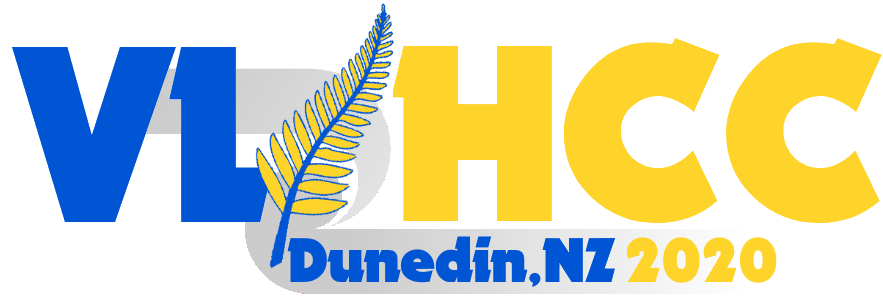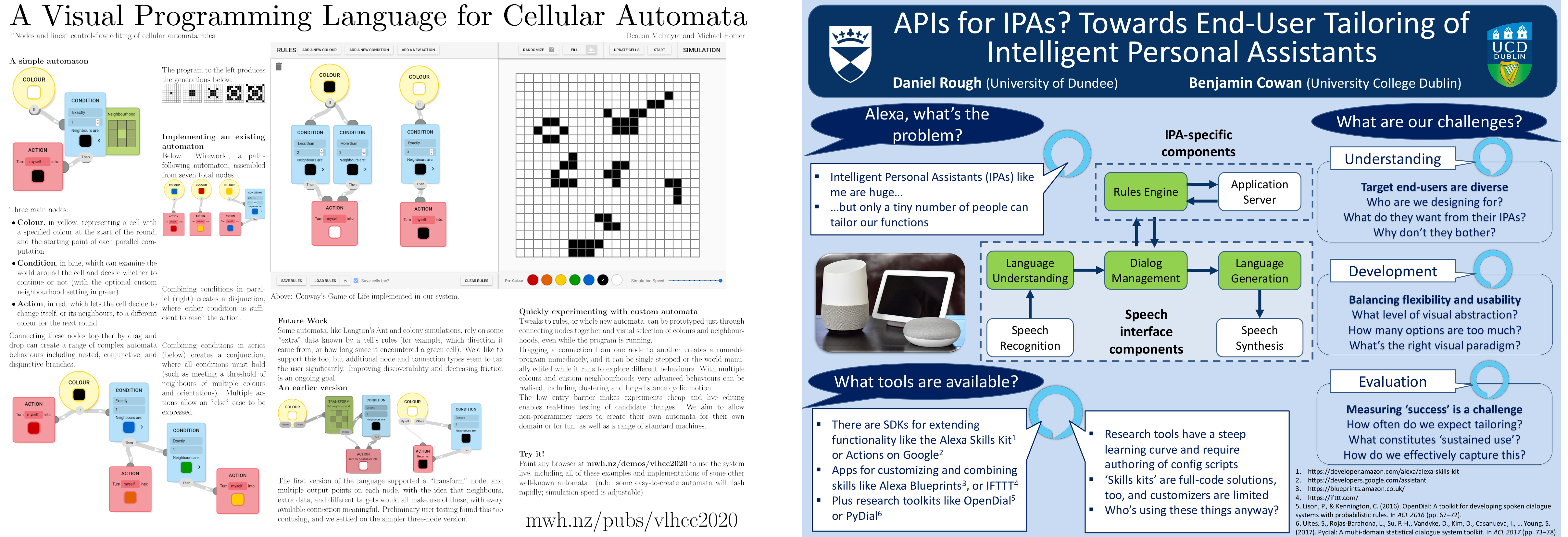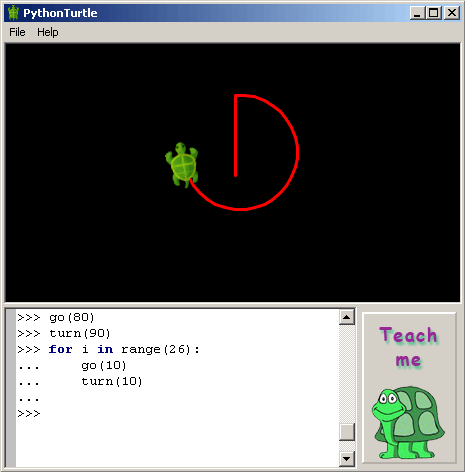This time last year, nobody could have anticipated the need for a Virtual VL/HCC. Lots of us were looking forward to meeting in the beautiful city of Dunedin, New Zealand (maybe not the long-haul flight, mind you) and enjoying a few days of talks, coffee break chats, and evening socials with faces old and new. To be honest I wasn’t sure how Zoomland could really compare, as I’m sure most people have felt after being told that their favourite conference is going to be fed to them via their monitor this year, but through the motivation of everyone involved, I think we made it work!

Apart from avoiding the quirks of cross-globe travel (jet-lag laughs in the face of conference coffee) a big benefit of moving VL/HCC online was the ability for many more people to get involved that would have otherwise been constrained by time, money, accessibility, family responsibilities, and everything else that can make it a real issue to get there. We had 100 attendees (a record for the conference as far as I know!) all of who could pop in and out of sessions as fitted their schedules and interests.

Graduate Consortium
Tuesday was the graduate consortium, chaired by Mike Lee and Steve Oney, who I’ve been told did a brilliant job managing the talks, breakout rooms and discussions, especially in the unenviable position of being our pilot testers for the Clowdr conference platform. I wasn’t there to pass judgment, but Sangho Suh, a grad student participant, kindly agreed to write a wee bit about his experience:
Sangho: This year, I had a wonderful time as an attendee at the VL/HCC’20 graduate consortium, thanks to the consortium organizers, Mike Lee and Steve Oney. They made everything easy for us, securing funding to pay for our conference registration costs and even taking care of the registration! The consortium opened with Mike and Steve welcoming us and introducing themselves. After they shared their fond memories as student attendees some—but not so long—years ago, we went around by continents and introduced ourselves.
One of the things I liked about this welcome session was that Mike set a safe, welcoming tone for everyone for the rest of the day. He remarked that some attendees are just starting their Ph.D. while others may be well into the program. Although I belong to the latter category, I would have appreciated this if I were attending as a new graduate student. The rest of the day consisted of a series of research presentations by students, and it ended with a session where faculties shared their experience and advice concerning various graduate students’ questions. Having attended a consortium in Toronto last year, I was looking forward to experiencing that same excitement of meeting and hanging out with the organizers and other attendees. While this was cut short and the interaction was limited to a virtual setting, I am really happy with how things turned out. I still got to connect and hang out with other students in the social breakout room. We chatted and exchanged ideas about each other’s work. I received valuable feedback and ideas for my research. And most importantly, it gave me—a first-timer to VL/HCC—a sense of belonging to the community.
Thanks again Sangho! Sounds like it was a very useful experience, and I hope the other participants felt the same. More than anything, I think it’s great to hear that newcomers to VL/HCC, despite the new way of doing things this year, still get that same sense of community belonging.
Day 1
Of course, even as a familiar community, online conferences still take a bit of time for everyone to ease into ‘virtual mode’ and cope with a new platform and whatever channels the organisers have decided to use. Clowdr was our platform of choice, which I thought worked great for integrating our conference program with everyone’s favourite tech of 2020 - Zoom! I’m glad we had that integration and didn’t have to handle too much new tech - the busy schedule meant we had to get our arses in gear quickly. Day 1 saw presentations of the first 12 papers across three sessions, lightning talks for showpieces/posters, and a keynote from Prof. John Grundy. We also had our welcome from General Chair and all-round vanguard of virtual VL/HCC, Craig Anslow, who showed us what we were missing in New Zealand.

This year’s theme was “Amplifiers for Human Learning and Creativity”, and understandably the majority of papers were focused on the learning part of things. It’s not that we don’t encourage creative thinking, but I guess creativity is a bit more difficult to measure. In any case, the first session was suitably “Supporting Learning by Novice Programmers”. There were papers on learning through comics and through conversations; through IDEs and internships. I don’t mean to gloss over papers, but there are a lot to get through! The next session was “Supporting Learners with Technology” - a subtle distinction, but of course you can be an experienced programmer and still need to learn new tech, right? This session included studies on how programmers use APIs, and how their understanding of new code can be improved through annotations.
Finally, the “Understanding and Helping Developers” was entirely focused on professional software developers and their needs. Most of us at VL/HCC have a good bit of experience with programming, but professional development is a very different kettle of fish and I’m always curious to hear about the issues real-world developers have.
After a wee break we were straight into the quickfire presentations for posters and showpieces (I had a poster so this is straight from the horse’s mouth). Each of us had a 2 minute “elevator pitch” video slot, followed by time for discussions where interested attendees could join breakout rooms with the presenter to ask questions. I had mixed feelings about this to be honest. The video pitch was fun and meant we only had to recite the poster schpiel once, but I felt the separate breakout rooms were a bit strange. I would’ve liked some sort of virtual poster gallery that anyone could walk around and have a look at. With the breakout rooms, viewing the posters themselves proved a bit difficult. Never fear, I’ve put them all on the conference website that you can look at here.

To round off the day we had Professor John Grundy deliver his keynote titled “Human-Centric Software Engineering”. John talked about his work investigating the issues and challenges to overcome in understanding end-users and why their software (doesn’t) support them. Humans are, fairly obviously, a major influence in the development of software, but what’s less obvious is how we include them and make sure we’re including the full spectrum of variability in our group of target end-users.

Day 2
Day 2 had three more sessions with 10 papers in total, as well as the announcements of awards. We started off with “Support for Collaboration”. I was the session chair for this one, which I’d never done before, so I was grateful that my presenters kept good time and had interesting stuff for me to ask about! Bashon: A Hybrid Crowd-Machine Workflow for Shell Command Synthesis - a full paper in this session - was my favourite.
Next was “Supports for Human Learning” - much like yesterday’s session, there was a mix of who the Human was intended to be - professionals in the workplace, experienced programmers encountering new software, and novice student programmers. As you might have figured out, learning was the driver of this year’s conference, and I learned a fair bit about learning! Some sort of meta-learning thing I suppose if you want to be fancy about it.
Finally, we had “Data Science”, which, with four papers, has fairly become popular this year. Stuff on who data scientists are, and how they use their tools like computational notebooks. These notebooks (like Jupyter) and the area of data science in general were fairly new ground to me, but I reckon we’ll see more on this topic as the ridiculous quantities of data become a greater challenge to manage.
THEN it was the exciting bestowal of awards! Ended up not being that exciting because I didn’t win anything but that’s no reason to deprive you of the results (you can also click here for the summary).

And of course, our conference social event, which couldn’t really be a dinner for what I hope are obvious reasons, so we had a VL/HCC quiz! I was responsible for this so it’d be unfair for me to give my opinion on how it turned out, but I dare say it was more tolerable than watching each other chew for an hour. Plus there were Kiwi-themed prizes - Manuka honey for 1st, New Zealand chocolate for 2nd, and a delicious, fibrous box of Weet-Bix for last place! There was a mix of conference-themed questions, New Zealand questions, and some general knowledge thrown in. It wasn’t quite the same experience as a fancy banquet but I hope everyone enjoyed it regardless. Here’s a sample question for those who missed it:

Day 3
The final day had three more sessions, 10 more papers, and significantly less hangovers than most final days of VL/HCC. The time zone difference also meant there was almost a full 24 hours recovery time, for those who had to get up ridiculously early for the previous day’s sessions (us Europeans got lucky here).
The first session of the day, “Adding Intelligence to Development Environments”, had two full papers that employed machine learning for inferring spreadsheet units, and for facilitating remote pair programming - a bit of VL and a bit of HCC respectively!
“Visualization and Interaction” also had a mix of topics across its three papers, including a journal submission that investigated how narrations improved understanding of InfoViz and a short paper where Toshiyuki Masui presented his tool for no-click browsing of hierarchical data. My personal favourite of this session was the work of Jampierre Rocha and his colleagues at Lenovo, who are developing a tool to translate Brazilian sign language into Brazilian Portuguese.
The final session, “Understanding and Supporting Creativity” included 5 papers that represented the second part of this year’s conference theme. Defining and understanding ‘creativity’ is a challenge enough in itself, so I enjoyed these papers for helping me think about what it means to be creative, and how it can be encouraged. I especially liked Disruption and Creativity in Live Coding - I’d never heard of live coding performances before so this was a great introduction to the idea and its challenges. 
Although the talks today were enjoyable, I’m sure none of the other presenters would mind me saying that the highlight was our second keynote speaker, Cynthia Solomon. “Inventive Minds: Active Thinking and Learning”. Cynthia shared videos, images, ideas and philosophies of the minds that brought programming to children and inspired VL/HCC, including Seymour Papert, Marvin Minsky, and herself.
Cynthia, along with Seymour and Wally Feurzeig, created the Logo educational programming language - the first venture into the world of programming for many of us - so it was brilliant to hear from the woman whose work planted the seeds for our own research, and very likely the conference as a whole!

Of course, a virtual conference was never going to be quite the same as having our VL/HCC community together in-person, but I think we’d all agree it was a bloody good try in the context of COVID-19. In the words of Craig, our General Chair, it was a “best effort approach” - and through the efforts of everyone who participated, from our home offices, living rooms and kitchens across the world, at 5pm, 5am, and every time in between, I really do think it was the best it could’ve been. Kia Kaha, and haere rā until next year!